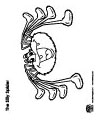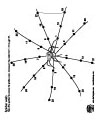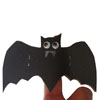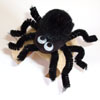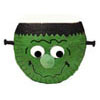Halloween Kids Activities
Spiders: Scary or Nice?
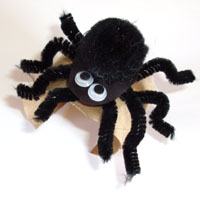
Objectives
Children will learn about
Materials
- Book: The Very Busy Spider
by Eric Carle
Directions
Language Activity
Read The Very Busy Spider
by Eric Carle. Talk about how the silk that the spider spins for its web comes from the inside of the spider’s body through small holes at the back called spinnerets. Explain that the silk comes out as a liquid but quickly dries in the air. A silk thread is very strong and looks like a strand of hair.
A young spiderling can use its spinnerets as soon as it is born. The spiderling puts out a silk line called a dragline. Show children a long piece of white thread with a plastic spider attached. Ask children: “What do you suppose the spiderling uses this line for?” Explain that when a spiderling sways on its line, it can catch prey. This is called ballooning.
Music and Movement:
Have children form a circle. Pass a spool of white thread around the circle and have children hold on to it. Together, try to lift the string up high in the air and slowly place it on the floor without breaking it. Let children walk on it.
Song:
One elephant went out to play
out on a spider web one day
She had such an enormous day
that she called for another elephant
to come to play.
Spider Craft: Balloon Spiderlings
Have each child blow up a black balloon and cut eight spider legs out of black craft paper. Then have them glue two eyes to the front of the balloon and two fangs on the sides. Tape the eight legs to the balloon and attach a piece of yarn to the top of the spider. Hang spiders from the ceiling.
To observe the ballooning effect, children can produce wind and have the spiderlings sway back and forth.
Spiders scary or nice?
Show children some pictures of various types of spiders. Ask them about their experiences with spiders. Do they like them or not? Make a chart. Look at different pictures of spiders. Discuss what spiders look like, what they do, and why children are or are not afraid of them. Explain that spiders have eight eyes but cannot see very well. Most spiders are very small and not dangerous. They help us by eating insects that we may not want to have around.
Music and Movement
Sing “Itsy Bitsy Spider” and have children perform the movements.
The itsy bitsy spider
climbed up the waterspout.
Down came the rain
and washed the spider out.
Out came the sun
and dried up all the rain.
And the itsy bitsy spider
climbed up the spout again.
Have children walk quietly like a spider to music. When music stops, spiders hide somewhere close and freeze. Teacher walks around to see if she/he sees a spider moving.
Learn more about spider
Other Resources






